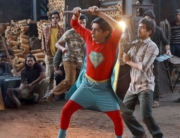There have been many recent films of note that explore the origins of a cinephile. Is it the desire to capture a sense of the cinematic experience that feels either gone, slipping away, or at a crossroads?
In watching writer/director Pan Nalin’s Last Film Show, I couldn’t help but think of the contrasts and parallels between Steven Spielberg’s autobiographical The Fabelmans, where the somewhat privileged protagonist is encouraged to explore filmmaking in 1950s and 1960s suburban America versus the nine-year-old Indian boy, Samay (Bhavin Rabari), in 2010, living in the state of Gujarat.
Both The Fabelmans and Last Film Show pose the mystery of why some become so enamored with movies and filmmaking—its mechanics, its storytelling, tricks, and visuals. Instead of Spielberg’s adventure to The Greatest Show on Earth, Samay is brought to the movies by his parents to see a religious film about the goddess Mahakali. Otherwise, “cinema is not appropriate for us,” his father says, yet the experience becomes a different kind of religious awakening for Samay. He is immediately drawn to this world: Before the movie begins, he runs to the screen to touch it, and as the film commences, he turns his head back, fascinated at the flickering light above.
After school, Samay helps his father, who makes tea for travelers on trains that pass through the countryside. Soon Samay, addicted, skips school to go back to the aptly named Galaxy Cinema, even befriending its projectionist, Fazal (Bhavesh Shrimali). Nalin’s script is rooted in the era of the transition away from 35mm film reels and projectionists to widespread digitalization. His movie pays many homages—most notably Cinema Paradiso in terms of plot—but it even opens with a title card of “Gratitude for Illuminating the Path” to the Lumière brothers, Eadweard Muybridge, David Lean, Stanley Kubrick, and Andrei Tarkovsky.
While the movie occasionally dazzles, there’s a simplicity and quiet beauty to Last Film Show. The subtle score by Cyril Morin adds to its sense of lightness and wistfulness. Particularly wonderful are Shreyas Beltangdy and Pavan Bhat’s editing choices. There are a few breathtaking moments of unexpected cuts and shots, especially in the meditative first half. Through Swapnil S. Sonawane’s vivid photography, ravishing colors emerge—not only clothes and saris, but in bottles and broken planes of colored glass; a pile of illustrated matchbooks; the loving, rhapsodic flits of imagery of movies (of various genre and perhaps, quality); and within the natural world as well—fields of tall green grass and blue skies. The images are often elegantly presented, with a textured sense of Samay’s world and his attraction to visual flair.
Additionally, Rabari’s performance as Samay is quite good, especially for a young, debut performance. There’s his physicality—for example, when he hurriedly crawls through the barred windows of his school for another escape to the Galaxy—and his varying emotional states. Sometimes you can visualize his mind running electrified as he processes all the images before him.
Yet as the movie wore on, I questioned if it was moving into a more fantastical, feverish dreamlike place. Are the kids around Samay that interested in helping him mount his own little theater with lights and scraps of film? When the movie becomes more frenetic and dreamier, it also becomes more tedious and distant. Yet perhaps Nalin’s purpose is to track the modulation of a sort of cinematic obsession—from distilled and quiet to busy and frantic. Later, Samay begins hoarding everything piece of 35mm film he can get his hands on in the face of its impending extinction.
Nevertheless, I loved where the movie ultimately goes. Once the discarded reels of 35mm film are dropped into bubbling hot cauldrons, they are molded into colorful plastics. As the narrator recites a frenzied roll call of filmmakers, we see the fate of discarded film reborn in a dizzying, vibrant array of bangles worn by women on a train—how can something be so sad and beautiful?







Leave A Comment